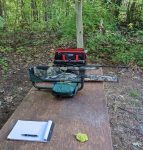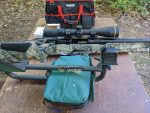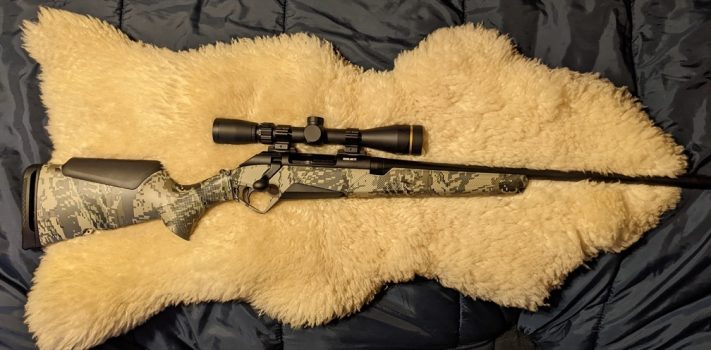I don’t know what your experience of the post-2020 ammo shortage has been. In our area, it seemed to go through a number of stages. In the first stage, the most commonly used calibers like 9mm, 5.56X45mm, and .308 Winchester sold out first. Then the less commonly used calibers gradually sold out in the order of their popularity. Then the most commonly used calibers gradually became available again at greatly inflated prices. Then some of the less commonly used calibers gradually became available again at even more greatly inflated prices. Then, prices gradually began to come down on the more commonly used calibers. Prices came down more slowly on less commonly used calibers, and some of the least commonly used calibers remained almost impossible to get at any price.
This pattern convinced me that I ought to give some attention to firearms chambered in the three most popular calibers. I already had firearms chambered in 9mm and 5.56x45mm, but I did not have anything chambered in .308 Winchester. I touched base with some of my contacts in the firearms industry about borrowing a rifle in .308 for testing and evaluation. I found out that there would be a long wait time due to demand. Their companies were selling rifles just as fast as they could make them, so they did not have any extra units on hand to loan out.
Then one day, I came across some information about Benelli’s new Lupo BE.S.T. rifle. Benelli is best known for their high quality shotguns, but they are now applying their gunmaking skills to bolt-action rifles as well. The Lupo BE.S.T. offered some exciting features in terms of accuracy and corrosion resistance. I decided to give it a try. I contacted Benelli, and they were kind enough to loan me a unit for testing and evaluation.
To cut to the chase, during the course of my testing, I found the Lupo BE.S.T. to display the outstanding fit and finish that one would expect from a rifle with a manufacturer suggested retail price of $1,899 . The finish on the bolt is particularly glossy, one of the most beautiful firearm finishes I have seen anywhere. The rifle is extremely accurate, well balanced, and has a good trigger. If you have the means to buy a nicer than average gun, this one would be a good choice.
First Impressions/Description
The Benelli Lupo BE.S.T. arrived in a sturdily designed cardboard box. In addition to the rifle, magazine, and bolt, the box contained the owner’s manual, a bottle of oil, a shim kit, and a L.O.P. kit.
The box also contained a certificate of accuracy. It stated, “Every Benelli Lupo is tested in house to certify its sub M.O.A. precision by shooting a 3-shot group at 100 yards.” The certificate indicated that the unit that I was evaluating shot 0.28 M.O.A. during its in-house test.
As I removed the rifle from the plastic bag in which it was shipped, one of the first things that impressed me was its excellent balance. The synthetic stock gives the impression of solidity, in contrast with the cheap plastic feel of many synthetic stocks. Although the stock appears to be a single piece, it actually consists of three different components: the buttstock, the stock around the receiver, and the fore-end stock. With the appropriate shim, L.O.P. and comb kits, the stock can be adjusted to 36 positions of drop, cast, and comb and 6 L.O.P. positions.
The stock on my evaluation unit is in the “Open Country” camo pattern. Lupo BE.S.T. rifles are also offered in the “Elevated II” camo pattern, and in AA-grade satin walnut.
The metal parts are well machined and finished, with no rattle, unevenness, blemishes, or extraneous tool marks. The heavy gauge polymer magazine fits flush with the bottom of the stock. Insertion is smooth and easy, but removal was somewhat difficult for my ten thumbs. I don’t think I could remove the magazine while wearing gloves. If I owned this rifle, I would try to polish the sides of the magazine with some very fine sandpaper to see if I could encourage it to drop out of the magazine well just a little more easily.
The 22-inch cryo-treated, free-floating precision barrel is threaded to accept muzzle brakes, flash-hiders, suppressors, and similar accessories. The barrel and the rest of the metal parts are attractively finished with the Benelli Surface Treatment (BE.S.T.). I will describe this treatment in more detail below.
The performance adjustable trigger can be set anywhere between 2.2 and 4.4 pounds. I found the factory setting right out of the box to be excellent in all of my testing. The beautifully finished bolt cycled as smoothly as butter throughout.
BE.S.T. Coating
The Benelli Surface Treatment (BE.S.T.) is a proprietary coating that provides extra abrasion and corrosion resistance. It is described by Benelli as “ a hybrid Physical Vapor Deposition (PVD) and Plasma Enhanced Chemical Vapor Deposition (PECVD) technology that applies a protective coating to parts. PVD and PECVD processes utilize electricity, radio frequencies, and plasma in a high vacuum environment to deposit a solid coating that precisely and uniformly covers the treated parts.”
Benelli is so confident in the process, that BE.S.T. treated parts are warranted against corrosion for 25 years from the date of purchase. The rest of the rifle enjoys a 10 year warrantee against defective parts and workmanship.
Benelli’s claims about the BE.S.T. treatment are pretty impressive. They claim to have tested treated parts by immersing them for several months in salt water without any resulting corrosion. They post pictures on their website to support those claims.
Since the Lupo shipped without the generous coating of oil that typically covers a new firearm, Benelli seems to have confidence in the corrosion resistance of the BE.S.T. coating.
The Manual
It is always instructive to take the time to read the manual of a new firearm. The first half of the manual was written in Italian, appropriately reflecting the Lupo’s place of manufacture. I chose to read the second half of the manual instead, which is in English.
It was easy to detect Benelli’s roots as a shotgun manufacturer in the manual. It had a tendency to refer to the Lupo as a “shotgun” from time to time. The manual also periodically referred to “gauge” rather than “caliber”. This was usually in sections that applied to firearms in general, like the safety warnings. Benelli’s technical writers need to edit a little more carefully after using cut and paste.
I found a number of other interesting tidbits as I read the manual:
∙ It indicates that the magazine can be loaded either by detaching it, or through the slot in the upper receiver when the bolt is open.
∙ They recommend waiting one minute before clearing a hangfire from the chamber.
∙ There are extensive directions with diagrams for changing the drop and cast of the stock.
∙ There is a very extensive set of exploded diagrams and parts lists that could be very helpful.
Mounting the Scope
I mounted aLeupold VX-Freedom 3-9X40 scope on the rifle. The first set of rings I tried were just a little too tall. The next set that I tried (Leupold Rifleman Medium Rings) were about as close as it is reasonable to expect right out of the box. I could have slapped a layer or two of moleskin on top of the comb if I had wanted, but it was not really necessary.
I then determined the proper eye relief, leveled the rifle and scope, tightened the rings evenly, and focused the scope
Some Reflections on Accuracy (and Full Disclosure)
 The size of a group of shots is measured at its widest point, minus the diameter of the bullets being fired. For example, imagine that you are firing a .30 caliber rifle. You have fired a three shot group from 100 yards. The measurement from the outermost points of the two bullet holes that were farthest apart is 2.6 inches. You are interested in the distance between the centers of those two bullet holes, so you would subtract .3 inches from the total to account for half the width of each of the two bullets. The maximum size of the group minus the radii of two bullets (which is, of course, the diameter of one bullet) gives you a group size of 2.3 inches.
The size of a group of shots is measured at its widest point, minus the diameter of the bullets being fired. For example, imagine that you are firing a .30 caliber rifle. You have fired a three shot group from 100 yards. The measurement from the outermost points of the two bullet holes that were farthest apart is 2.6 inches. You are interested in the distance between the centers of those two bullet holes, so you would subtract .3 inches from the total to account for half the width of each of the two bullets. The maximum size of the group minus the radii of two bullets (which is, of course, the diameter of one bullet) gives you a group size of 2.3 inches.
A group size of one inch at 100 yards is a 1 M.O.A. (minute of an arc) group. A two inch group at 200 yards, a three inch group at 300 yards, and a four inch group at 400 yards are also all 1 M.O.A. groups. By the same token, a .75 inch group at 75 yards, a .5 inch group at 50 yards, and a .25 inch group at 25 yards are also 1 M.O.A. groups, although the smaller scale of the shorter ranges results in less precision in measurement. A group size smaller than 1 M.O.A. is called sub-M.O.A.
For much of the 20th century, production rifles that were capable of shooting 1 M.O.A. or smaller groups were not all that common. A 2 M.O.A. rifle was considered pretty good. People of average marksmanship ability were capable of distinguishing between more and less accurate production rifles (for example, distinguishing a 2 M.O.A. rifle from a 3 M.O.A. rifle).
 In the 21st century, manufacturing techniques have improved to the point that many production rifles are now guaranteed to shoot sub M.O.A. It is difficult for people of average marksmanship ability to distinguish the relative accuracy of two sub M.O.A. rifles (for example, to distinguish between .25 M.O.A. rifle from a .75 M.O.A rifle). This is because you need to be a fairly good marksman just to shoot a 1 M.O.A. group, no matter how accurate your rifle.
In the 21st century, manufacturing techniques have improved to the point that many production rifles are now guaranteed to shoot sub M.O.A. It is difficult for people of average marksmanship ability to distinguish the relative accuracy of two sub M.O.A. rifles (for example, to distinguish between .25 M.O.A. rifle from a .75 M.O.A rifle). This is because you need to be a fairly good marksman just to shoot a 1 M.O.A. group, no matter how accurate your rifle.
For most SurvivalBlog readers, this is not a practical issue. Their targets, such as the vitals of a deer, are substantially larger than 1 M.O.A. at the distances over which they are shooting. Most of them, like me, will be as well served by a 1.5 M.O.A. rifle as by a sub M.O.A. rifle.
Some SurvivalBlog readers may be unusually accurate marksmen. In the interest of full disclosure, I am informing those readers that my evaluations of a rifle’s accuracy may not be as helpful to them as one could wish. I am not a good enough marksman to exploit the full potential of a sub-M.O.A. rifle.
The First Range Session
I went to the range behind my pole barn for my first range session with the Lupo. There I did my preliminary testing from a range of 25 yards. I like to begin at that distance because it is easier to get the first sighting-in shot on paper from 25 yards than it is from a greater distance. It is also easier to repeatedly walk the shorter distance from the shooting table to the target stand and contemplate what one finds there.
The maximum distance I can shoot on my range is 50 yards. Beyond 50 yards, a fold in the land hides my target stand.
I put the Lupo in a lead sled and chambered a single round of Federal 130 grain JHP Varmint and Predator. As I fired the first shoot, I was impressed with the smooth and crisp operation of the trigger. The first shot struck three inches high and six and a half inches to the right of the point of aim. I adjusted the scope and fired single shots a couple of more times. The third shot hit dead center at the point of aim.
I then began shooting three shot groups with the Federal ammo. The groups were adequate, but nothing to brag about.
I switched to Winchester 149 grain FMJ ammo. This is your standard M80 7.62X51 NATO Ball ammo from the Lake City ammo plant. The groups improved significantly. The point of impact was slightly different from that with the Federal ammo, so I adjusted the scope accordingly. By the end of the range session, my final three shot group was a single hole in the middle of the target about ½ inch across at its widest point. This would constitute a roughly 1 M.O.A. group for .30 caliber bullets at 25 yards, which is pretty good for standard ball ammo.
The Second Range Session
Several hours later, I had some friends over to my house for a range day. At the end of the session, I asked them to shoot the Lupo and share their thoughts.
“Glock 17″ is an excellent marksman. From 25 yards he fired three rounds that produced a single hole only marginally larger than the hole produced by a single .30 caliber bullet. He observed that the Lupo is very accurate, has a great trigger, and a smooth action. He also liked the location of the safety.
The rest of the guys could not match Glock 17’s accuracy, but they were pleased with their groups and with the rifle as well. “Gibbs” commented on the excellent trigger, and the smooth action of the bolt. “Runningman” liked the trigger and the overall appearance of the rifle. “Newby” liked the trigger and the fit of the rifle.
The Third Range Session
For my final range session, I went to the local rod and gun club to do some testing on their 100 yard range. After some minor sight adjustments using the Federal 130 grain JHP, I switched to the M80 ammo.
I was shooting from sandbags provided by the club. I quickly began to miss the lead sled. It was not a really matter of excessive recoil: Benelli’s Progressive Comfort recoil system works fairly well. But my bones just seem to rattle a little more now than they used to, and I really enjoy the comfort provided by the lead sled.
My best three-shot group at 100 yards was 1.2 inches, for a 1.2 M.O.A. As I noted above, the reason this group was not better is due to the limitations of the shooter, not the rifle.
I did have one thought that I want to try out at my next 100 yard range session. In the movie The Patriot, Mel Gibson’s character, Benjamin Martin, had some good shooting advice for his sons. That advice was “Aim small, miss small”. When shooting from 100 yards, I have not typically been able see the marks at the center of the targets, even with the scope dialed all the way up to 9X. Instead, I am just trying to shoot the center mass of a six inch black blob. If I used a target with a one inch black dot in the center rather than a six inch black blotch, then I might have better results.
Cleaning
I cleaned the rifle after the first two range sessions and after the last. The process was very simple, straightforward, and unremarkable both times. I used Benelli oil for the first cleaning as suggested by the manual. I used kerosene as a solvent and CLP as a lubricant for the second cleaning, as is my usual practice. The bolt continued to cycle with buttery smoothness regardless of the cleaning products used.
Conclusions
The Benelli Lupo BE.S.T. in .308 is an outstanding rifle. It is extremely accurate, nicely finished, smooth operating, and corrosion resistant.
Benelli claims that it is “The Finest Production Bolt-Action Rifle Available.” Other manufacturers may contest that claim. Based on my experiences, I can at least say that it is a very fine rifle indeed.
The $1,899 manufacturer-suggested retail price is a bit pricey for someone of my humble means. But if you have the means and desire to purchase a rifle of this quality, this one would be an excellent choice.
Disclaimer
Benelli was kind enough to loan me a sample of their Lupo BE.S.T. in .308 for testing and evaluation. I tried not to allow their kindness to interfere with my objectivity, and believe that I have succeeded. Leupold provided me with a sample of their VX-Freedom 3-9×40 scope for review for an article that I wrote previously. Caldwell provided me with a sample of their Lead Sled 3 for use in an article that I wrote previously. I did not receive any other financial or other inducement to mention any vendor, product, or service in this article.










